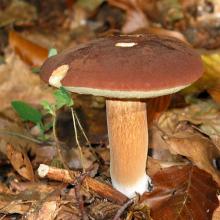Boletus edulis
Common name:
Porcini
Genus
Boletus
Family:
Boletaceae
Order:
Boletales
Imleria badia
Common name:
Bay bolete
Genus
Imleria
Family:
Boletaceae
Order:
Boletales
Boletus edulis
Common name:
Porcini
Genus
Boletus
Family:
Boletaceae
Order:
Boletales
Imleria badia
Common name:
Bay bolete
Genus
Imleria
Family:
Boletaceae
Order:
Boletales
Boletus edulis
Common name:
Porcini
Genus
Boletus
Family:
Boletaceae
Order:
Boletales
Imleria badia
Common name:
Bay bolete
Genus
Imleria
Family:
Boletaceae
Order:
Boletales
Family (Fungi): Boletaceae
The Boletaceae are a family of mushroom-forming fungi, primarily characterised by small pores on the spore-bearing hymenial surface (at the underside of the mushroom), instead of gills as are found in most agarics. Nearly as widely distributed as the agarics, the family is renowned for hosting some prime edible species, such as the Cep or King Bolete (Boletus edulis), highly sought after by mushroom hunters worldwide. A number of rare or threatened species are also present in the family, that have become the focus of increasing conservation concerns. As a whole, the typical members of the family are commonly known as boletes.
Boletes are a reasonably safe group of mushrooms for human consumption, as none of them are known to be deadly to adults. Edible bolete species are especially suitable for novice collectors, since they pose little danger of being confused with deadly poisonous mushrooms, such as deadly Amanita species which bear gills instead of pores in their hymenial surface. Some boletes are toxic and may cause gastrointestinal poisoning if consumed, but these are unlikely to be confused with popular edible species in the family.
The family has been the subject of extensive systematic revisions in recent years, as some of the early established genera (particularly Boletus, Leccinum and Xerocomus), have revealed to be highly polyphyletic, and the original number of genera within the family had been underestimated. As a result, several new species and genera have been described from Asia, Europe and North America, while many existing species have been transferred to different genera, in concordance with phylogenetic results.
Description
Most species of Boletaceae produce large, fleshy mushrooms, with a more or less central stipe. The fruit bodies typically have tubular hymenophores, although a small number of species (e.g. Phylloporus) are lamellate. The spore deposit colors are commonly olivaceous (yellowish-green), yellowish, brownish, or vinaceous (red-wine colored), and when viewed under the microscope spores are usually fusiform or subfusiform. In many species, parts of the fruit body will turn blue, red, or black when bruised or exposed to the air, as a result of the oxidation of pulvinic acid derivatives, like variegatic, xerocomic, and atrotomentinic acids.
Reference: Wikipedia


